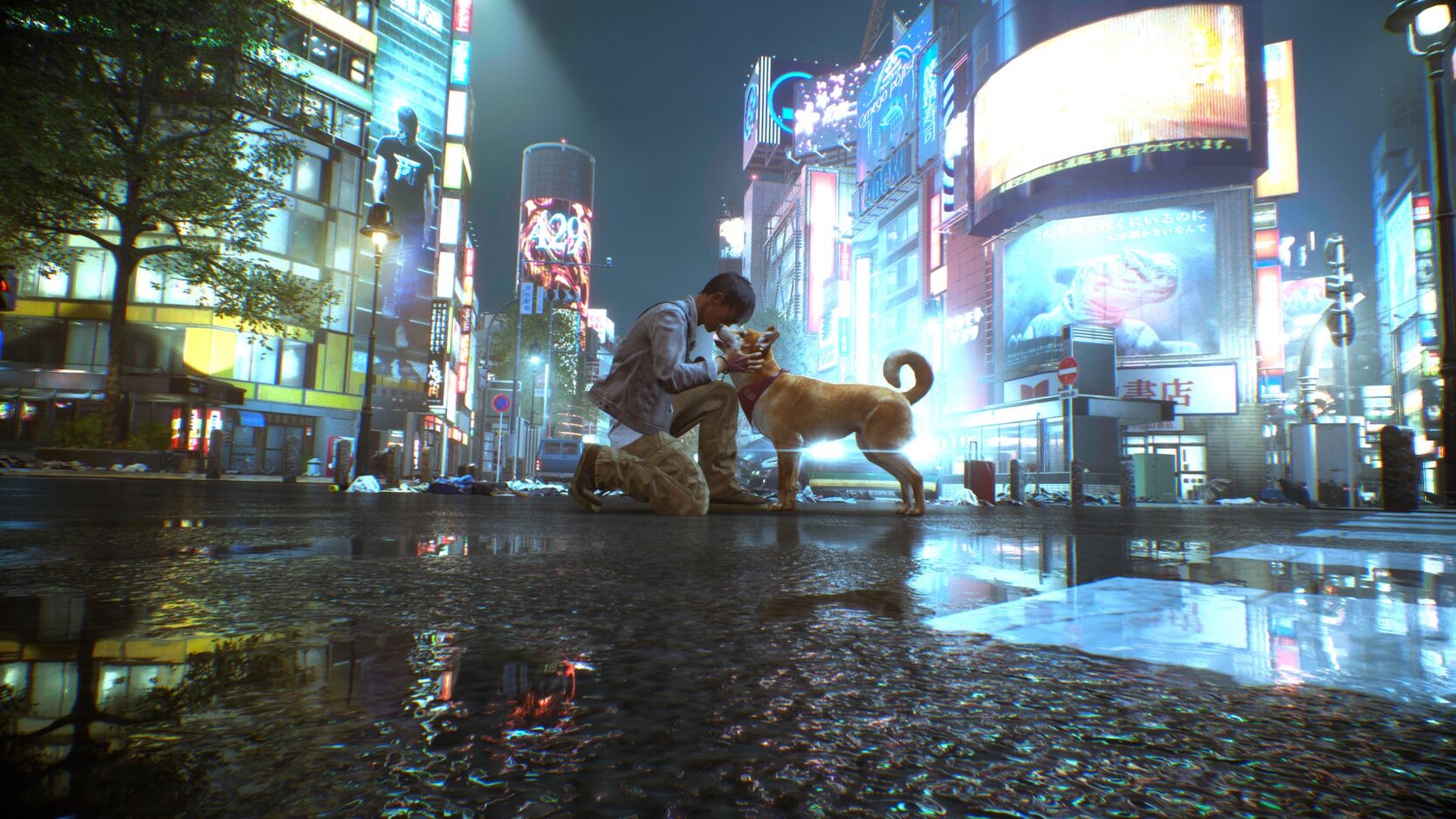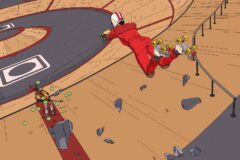In the crowded landscape of video games known as Spring 2022, Ghostwire: Tokyo serves as the only paranormal vacation to Japan.
Of course, since it’s made by the Japanese horror masterminds at Tango Gameworks, digital travelers better be ready for some visits from spirits, demons, and various other creepy crawlies (often based on Japanese folklore) on their trip. After all, the version of Tokyo presented in Ghostwire: Tokyo is nearly devoid of regular human life — instead filled with “Visitors” who aren’t always the friendliest of guests.
With a unique take on modern Tokyo and a variety of ghastly enemies to take down, the first-person action-adventure title veers pretty far from Tango’s previous Bethesda-published entries in The Evil Within series — and simultaneously separates itself from just about anything else available on the PS5 these days.
SPIN sat down on a video call with game director Kenji Kimura, producer Masato Kimura and composer Masatoshi Yanagi to chat (through a translator) about the new title.
SPIN: What went into creating this relatively unique setting of a reimagined version of modern Tokyo for Ghostwire: Tokyo?
Kenji Kimura: From the game standpoint, we wanted to make something really fun, regardless of what the genre was. So we started with this idea of trying to make a game that allows the player to experience the fun parts and the appeal of the city of Tokyo. Tokyo is a city with a lot of different cultures that are mixed together — some young and new, some very old and traditional. There’s a lot of history mixed in with a lot of modern and cutting edge things in the city. We set our minds on making the city first, and then figuring out how we can apply the storyline and gameplay to it later. So we just kept chugging forward with making the city, and that’s not really the normal way of making games. It’s not a recommended path for others to take, because it was very difficult with how we approached this — but that’s probably one of the reasons why the atmosphere of the game turned out to be so unique.
Masatoshi Yanagi: On the music side, we utilized the same vision. We wanted to represent Tokyo the way it is — with the mixture of the cultures old and new, and a lot of tradition. So in the music, we utilized all Japanese traditional instruments and mixed it in with the latest cutting-edge synthesizer sounds. And since the game is a PS5 exclusive, we also wanted to focus on using the PS5’s audio features that allow for the player to feel immersed in sound — because that’s also a big part of Tokyo. When you’re walking around Tokyo, the city has a lot of noise and sounds that you’re always hearing, so we wanted to recreate that sense and utilize a lot of the sound features that were available.
Seeing as Tango Gameworks obviously comes from a horror background, how did you go about adding horror elements and your well-known monster design to this more action-heavy title?
Kenji Kimura: There are urban legends from the old times in Japan that get passed on from grandparents to grandchildren, and sometimes they change in their very nature as they’re being told. Sometimes they get updated to be set in modern times, so they evolve over time. But they tend to not be about a strange being that just jumps out of nowhere or anything like that. Instead, they tend to be more about seeing something moving in the darkness, and as you check it out and get closer to the darkness, you notice there was somebody standing there. Then as they get even closer, you notice that the person there doesn’t have a face. And then it stops right there, and it’s up to the person telling the story or the listener in regards to what the takeaway should be from that story. We wanted to do a similar design approach with the Visitors in the game. They’re based on some of the urban legends, and you’ll see that from afar, they look like normal humans — but as you get closer, there’s something off about them. They might not have a face. They might not have a head. They might not have legs. There’s the sense that something’s really off. From there, it’s just the timing of when you notice it and when the spookiness hits you. That sensation is something that we really wanted to have in the game, so the enemy designs are based on that.
Masatoshi Yanagi: Because the urban legends don’t jump out at you or attack you immediately, we avoided sounds that would typically be used for jumpscares. Instead, we chose sounds that tend to linger in your mind or stay with you for a little longer. Sounds that caused a feeling of grief or sorrow were chosen instead of immediate feelings of fear. The sounds were deliberately chosen to help create this atmosphere that’s a little bit more unique.
The urban setting of Ghostwire: Tokyo provides a very different experience for exploration and whatnot than most “open world” games. Considering how much emphasis was placed on the atmosphere, how did the open world gameplay factor into the design?
Kenji Kimura: When I think about the negative side of open worlds, the easiest example would be if there’s a really open field that’s just grass, and then there’s a cottage in the distance that I need to go to. But in our game, we’re mixing the paranormal with the normal. The vision is to experience the unordinary within the ordinary. That means there’s a city that has a lot of ordinary in it, but there’s also a lot of unordinary things — sometimes hidden and sometimes right in your face — all over the city. We wanted to allow the player to see things that they would normally not be able to see. That includes spirits, but also things on top of roofs of buildings. There’s a lot of verticality in this game and a lot of fun to be had on the rooftops, which created a need to allow the player to get there very easily.
.
Masato Kimura: We took the fun of Tokyo and put it into this game. We didn’t just use one part of the city, we did a lot of footwork and research by taking walks and looking all around Tokyo to pick and choose the things we liked about each area, We didn’t just choose the sightseeing and touristy places, we chose places that were interesting to us, like random blocks of government buildings, apartments, and abandoned houses that are just filled with trash and dark alleys. We took them and stitched them together to make a condensed map that’s filled with a lot of interesting things that are easier to access.
Masatoshi Yanagi: It’s a little bit more difficult to create smart sound design for an open world-ish type of gameplay system like this in comparison to a linear game, because it’s harder to create and control the emotional cues. But one of the appeals of Tokyo is that while walking around, just by turning a corner or walking down the street, you could go from brand new office buildings directly into a shrine or some kind of neighborhood with just little old one-story houses. That kind of immediate switch feels like you just stepped into another world, and it’s something that we were able to also utilize on the sound side by creating shorter songs that can switch while you’re walking around. It still felt fitting for this situation, because this game utilizes a city where things can change just by taking a few steps. Also, the game does have some linear moments where you can do scripted things for the emotional experience, and we were very able to hone in on those key moments and make sure that the sound and the music can help supplement what’s going on.
With all of the massive titles releasing over the past couple of months, what can people expect from Ghostwire: Tokyo that really isn’t in any of these other games?
Kenji Kimura: I’ve been telling people that we’ve created a paranormal version of Tokyo that you can go sightseeing in. We started creating the game before the pandemic, but the pandemic kind of created this paranormal scene in real life where we weren’t able to go outside, and a lot of people felt kind of helpless because it’s this virus that we cannot see to fight against. In the game, you have paranormal powers to fight against the paranormal situation, so hopefully people can take the stress that they felt in real life and use that in the game. Being able to fight against that all that paranormal stuff and will hopefully allow people to relieve that stress that they felt in real life
Masatoshi Yanagi: We used 3D audio and sonic tools to fully immerse the player in both the paranormal and normal Tokyo that we’ve created. I hope that people get a chance to play this on the best headset that they can, because they’ll really experience the Tokyo we’ve created and feel like they’ve been enveloped by the sound. It’s like a virtual trip rom the comfort of their own sofa.





